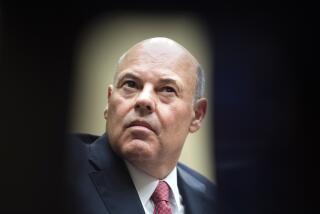Stock losses leave pensions underfunded by $400 billion
The collapse of the stock market last year left corporate pension plans at the largest companies underfunded by $409 billion, reversing a $60-billion pension surplus at the end of 2007, according to a study released Wednesday.
Shoring up the plans could cause further pain for workers, businesses and the struggling economy at a time when they can least afford it, pension specialists said.
“The chaos that has been observed in the world’s financial markets over the last 12 months has had a major adverse impact on pension plan funding and will negatively impact corporate earnings,” the Mercer consulting firm reported Wednesday. “Moreover, the trend in recent months has been one of alarming deterioration.”
As Mercer and other pension specialists described it, the pension problem illustrates how the recession and the meltdown in the financial markets can become self-reinforcing.
Ballooning pension deficits will leave some companies with diminished profits, weaker credit ratings and higher borrowing costs, which can translate into lower stock prices, Mercer principal Adrian Hartshorn said. The need to cover pension shortfalls could prompt businesses to reduce spending on items as varied as equipment that boosts productivity and dividends that deliver income for shareholders.
Though shoring up pension funds is supposed to increase employees’ financial security, it could involve such trade-offs as reductions in wages, benefits and jobs, said Mark Warshawsky, director of retirement research at Watson Wyatt Worldwide, another consulting firm. It also could prompt companies to freeze the amount of pension benefits employees can accrue, he said.
But the overall economic effects may be more complicated, pension specialists said. Funding shortfalls will force companies to boost their pension investments, contributing to demand for stocks and bonds.
Mercer’s monthly snapshot of corporate pension plans focuses on those offered by employers in the Standard & Poor’s index of 1,500 big corporations. As the yer ended, 772 of those companies offered traditional pensions. Using the accounting methods companies must follow when they prepare their financial statements, Mercer estimated that the S&P; 1,500 pension plans held enough assets overall to cover only 75% of their obligations, down from 104% at the end of 2007.
Precise figures won’t be available until companies issue their annual reports for 2008 in the coming months.
Pension deficits are far from unprecedented. As recently as March 2003, the funding level for plans in Mercer’s study was 73.2%.
When pension plans are underfunded, companies are required to plow enough additional money into the funds each year to correct the imbalance over several years. This year, Mercer estimates that the companies in its study will end up reporting about $70 billion of pension expenses, up from about $10 billion in 2008. That would equate to an 8% reduction in annual profits compared to 2007, the most recent year for which companies have reported full annual results, Mercer said.
Watson Wyatt looked at the issue from a different angle but found a similar trend. It tried to assess in aggregate the condition of all pension plans sponsored by individual corporations in the United States, and it used a different set of measures -- the rules that govern the actual amount of cash companies must plow into their pension funds.
Watson Wyatt estimates that corporate pension plans began 2009 with $1.63 trillion in assets and $2.12 trillion in liabilities, Warshawsky said. The firm estimates that companies will have to more than double their contributions to pension plans this year, to $111.2 billion from $50.5 billion in 2008, he said.
Both Mercer and Watson Wyatt advise companies on employee benefits.
Some business groups have been calling for relief from the federal law that would force them to boost pension fund contributions in the short run, and the government has already eased some requirements. Relaxing the requirements could entail a different compromise -- the health of the pension plans.
Even before the current recession, traditional pension plans that promise fixed retirement benefits were an endangered species for workers in the private sector. They have largely been supplanted by 401(k) plans, which offer no guaranteed payouts.
Like pension funds, Americans’ 401(k) accounts have generally plummeted over the last year, and some companies have added to the strain by cutting matching contributions.
Whether the responsibility rests with corporate pension fund managers or individual employees managing their own accounts, the nation’s ability to convert relatively low savings rates into comfortable retirements depends on investments not merely outstripping inflation but delivering strong and stable returns over the long run. That proposition has been sorely tested of late.
Keith Ambachtsheer, an advisor to pension funds, says the nation may be in store for “a radical rethinking of how we deliver pensions to private-sector workers.”
Increasingly, the burden may fall to taxpayers, as it has with other aspects of the nation’s financial trouble, said Kent Smetters, an associate professor at the University of Pennsylvania’s Wharton School.
When companies go bankrupt and are unable to shoulder their pension obligations, the federally chartered Pension Benefit Guaranty Corp. steps in and covers the shortfall, subject to legal limits that would leave many higher-paid workers with smaller pensions than they had been promised.
The PBGC is funded through insurance premiums paid by employer-sponsored pension funds, but Smetters predicted that it eventually will need a federal bailout.
As of Sept. 30, when its last fiscal year ended, the PBGC reported a deficit of $11.15 billion.
--
Hilzenrath writes for the Washington Post.
More to Read
Inside the business of entertainment
The Wide Shot brings you news, analysis and insights on everything from streaming wars to production — and what it all means for the future.
You may occasionally receive promotional content from the Los Angeles Times.









